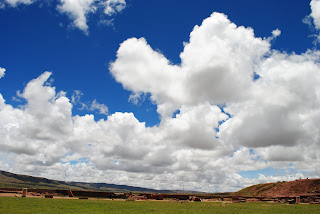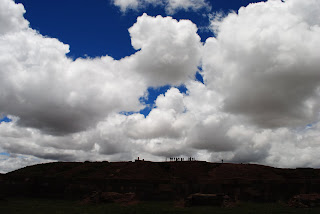We went back to the awesome Santiago Museum of Pre-Colombine Art today - a fantastic museum with pieces from all over the Andean, and wider South and Central American, indigenous worlds. Definitely a place to visit if you come to Santiago. We went to this museum months ago when we first arrived in Santiago but, having traveled around some of the areas covered by the museum, and visited various sites and museums in those places, we decided to go back with a better understanding. This reminded us that we had been saving a post on Tiwanaku, a fantastic archaeological site that we visited up in Bolivia, near Lake Titicaca, back in February. So here it is.
 |
| on the way to the temples - great weather! |
As with the smaller San Pedro de Atacama in Chile, Tiwanaku was located on various caravan routes between highland and lowland areas - as well as sitting at the centre of a trading network its proximity to the huge Lake Titicaca gave it access to key resources. There is evidence at the site of advanced irrigation methods which enabled the occupants to grow agricultural surpluses.
We're pleased to report also that again we had amazing weather, a little cold - we were at almost 4,000 metres above sea level - but with bright sunshine virtually all day.
Before we go into the archaeology, some modern context. It's fair to say that Bolivia as a country has on the whole struggled in post-colonial times. Stuck between Chile, a booming nation which can trace much of its modern economic success to defeating Bolivia (and Peru) in the War of the Pacific, and Peru which, while still poor, has a much larger share of the tourism market than Bolivia, due largely to the world-famous Machu Picchu. Now landlocked and poor, there is no obvious route to economic development for Bolivia, though it has certainly had some success with social development, providing an example to other post-colonial governments on how to treat indigenous people fairly.
Because the Inca Empire was at its height when Europeans arrived in South America, the Incas have always been in the European consciousness, and their civilisation is an ancient highly cultured one associated with Peru. The Tiwanaku civilisation was only re-discovered later, and it's a source of irritation to some Bolivians that the South American civilisation that springs to mind, to a European or North-American, is the Inca. The Bolivian President Evo Morales was invested with his powers at Tiwanaku in a ceremony partly based on Aymaran rituals (give the video a couple of minutes as it gives some good views of the site). This was undoubtedly a political move charged with symbolism, Señor Morales wants to be seen as a man of the people, but also a show designed to boost the pride of the Bolivian nation - their ancestors once ruled an empire over their neighbours, and formed the basis of later cultures.
 |
| view towards the village near the site |
Alaxpacha - the sky or heavens, represented in Tiwanakan iconography by the Condor;
Akapacha - the earth, represented by the Jaguar;
Mankepacha - the underworld, represented by the Snake.
Those places sound familiar, nobody in the world is all that different from anyone else in what they believe when you get down to basics. Sorry, no pics (the museum didn't allow it), but the iconography of these three sacred beasts appears all over Tiwanakan monumental architecture, statues, and ceramics (like the Jaguar pot linked to above from the museum collection in Santiago).
The Tiwanakans represented these worlds literally, by building three main temples at their religious centre: firstly the Subterranean Temple, a sunken structure - the temple of the underworld.
 |
| it contains these spooky faces - maybe ancestors |
 |
| a temple for honouring the dead |
 |
| from inside the temple of the underworld |
The temple has two main entrances: this at one end is the solstice gate - certainly part of the function of this temple was as a ceremonial and agricultural calendar.
 |
| the monumental exterior wall of the temple of the earth |
 |
| advanced construction techniques - metal "keys" were placed in those grooves to anchor the wall stones |
 |
| the Spanish tried to destroy this guy but had to settle for scratching a cross on his shoulder - if you click and expand you can see the carved Tiwanakan patterns |
 |
| this guy is part of the evidence for the geographical extent of the Tiwanakan Empire - an equivalent statue has apparently been found on the coast north of Arica in Northern Chile |
 |
| the Sun Gate - with a person giving an idea of scale |
 |
| the Stargate inside the museum |
Anyway, in the musuem at Tiwanaku is a series of extended skulls, of the type that get UFO theorists very excited. We didn't get any photos as photography was prohibited in the museum, but there's some on that link above. Unfortunately there's a far simpler explanation than these extended "cone-head" skulls being aliens: that it's possible, by binding a child's skull from a young age, to cause the skull to grow upwards like a cone. As inconceivable as that sounds (who would mutilate a child?), members of elite castes such as royalty or aristocracy have always of course been identifiable from birth (because membership of the caste is defined by the identity of one's parents) so the process could be started early. It seems that for various ancient peoples these extended heads were a way of distinguishing elites (by birth) from ordinary people, such as in Pharaonic Egypt (this link gives some great examples but is a bit silly - it even goes all David Icke at the end). It's not even that bizarre or particularly cruel when you think about other examples of "civilised" body mutilation, like Chinese feet binding. Nowadays the sacrifice required from the most privileged (in an aristocratic sense) in our society is endless grinning and waving.
Back to the temple of the earth...
 |
| Detail of the Sun Gate |
The photo above was a fantastic moment when our guide demonstrated the stone "amplifier" inside the temple of the earth. You can see him behind the wall, he's speaking into the hole in the stone, which was specially cut to amplify the voice to enable everyone to hear - the temple itself is huge, so this is a really clever piece of ancient engineering.
Now the temple of the sky, basically a large mound, partially reconstructed to show how it would have looked - like the sort of stepped pyramid that we're all familiar with from various images of South/ Central American civilisations.
 |
| right hand corner |
 |
| standing stones on top of the temple of the sky |
On top of the mound is a sunken pit which, although it's not clear today, has through excavation been shown to be in the shape of a large Andean cross.
It's not known if this is definitely the case, but it's believed that the pit would have been full of water - at night it would have reflected the stars. The Andean cross finds its mirror in the night sky in the southern hemisphere - there's no pole star down here, instead stargazers navigate using the Southern Cross.
 |
| our Andean Cross shaped joss stick holder thing |
That's Tiwanaku, an incredible place and a must-see in Bolivia. And, we almost forgot, you get to eat lovely salmon there, fresh from Lake Titicaca!
 |
| some more views across to the modern village |
chao!

























No comments:
Post a Comment